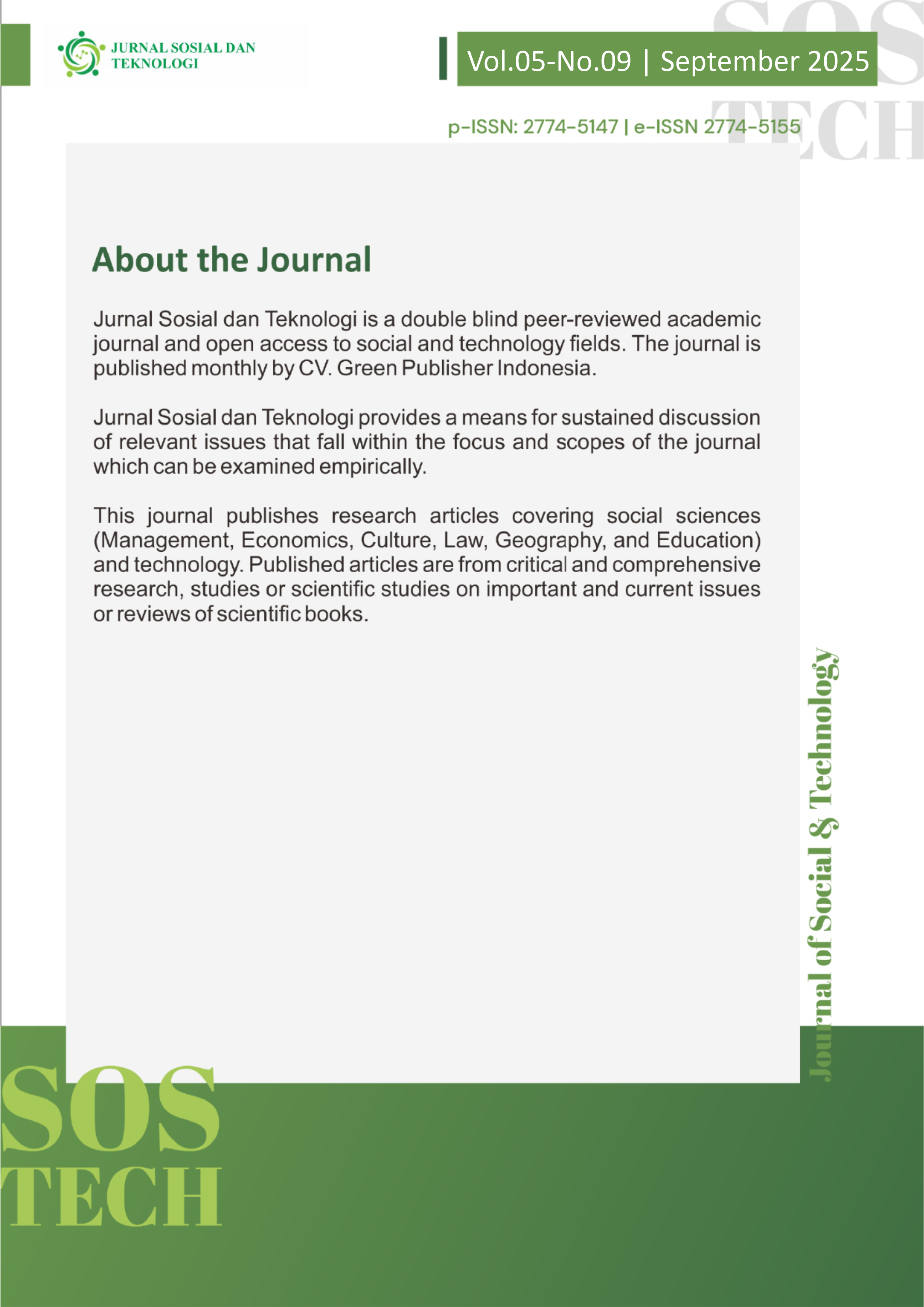Strategi Komunikasi Pemerintah Kota Banjarmasin dalam Mengimplementasikan Program Zero Waste to Landfill
DOI:
https://doi.org/10.59188/jurnalsostech.v5i9.32429Keywords:
Strategi Komunikasi, Zero Waste to Landfill, Pemerintah Kota Banjarmasin, Sampah, Transtheoretical ModelAbstract
Penelitian ini bertujuan untuk menganalisis strategi komunikasi yang dilakukan oleh Pemerintah Kota Banjarmasin dalam mengimplementasikan program Zero Waste to Landfill (ZWTL), sebagai respons terhadap permasalahan pengelolaan sampah yang semakin kompleks. Kota Banjarmasin memproduksi sampah sebesar ±650 ton per hari, dengan sebagian besar berupa sampah organik. Program ZWTL merupakan upaya untuk mengurangi sampah yang dibuang ke Tempat Pembuangan Akhir (TPA), dengan mengutamakan pengelolaan sampah dari sumber melalui prinsip 3R (Reduce, Reuse, Recycle). Penelitian ini menggunakan pendekatan kualitatif deskriptif. Teknik pengumpulan data dilakukan melalui wawancara mendalam, observasi, dan dokumentasi. Informan terdiri dari pejabat Dinas Lingkungan Hidup (DLH), kader lingkungan, tokoh masyarakat, dan warga yang terlibat dalam pelaksanaan program ZWTL. Data dianalisis menggunakan model interaktif Miles dan Huberman, serta diuji keabsahannya melalui triangulasi sumber dan teknik. Hasil penelitian menunjukkan bahwa strategi komunikasi yang diterapkan mencakup komunikasi edukatif, persuasif, dan partisipatif. Komunikasi dilakukan melalui berbagai saluran, termasuk media sosial, forum warga, pelatihan kader, dan penyuluhan langsung. Hambatan yang ditemukan meliputi keterbatasan armada pengangkut, fasilitas pengelolaan sampah yang belum merata, serta rendahnya kesadaran dan partisipasi masyarakat. Perubahan perilaku masyarakat dianalisis menggunakan Transtheoretical Model (TTM), yang menunjukkan bahwa sebagian masyarakat berada pada tahap kontemplasi hingga tindakan. Program ZWTL memberikan dampak positif dalam membangun kesadaran masyarakat, namun memerlukan penguatan strategi komunikasi berbasis lokal.
References
Adawiah, W., Kartika Hanindraputri, E., & Kamalsyah, M. A. (2024). Leadership, Innovation and Community Participation Pillar of Institutionalization in Bank Sampah Induk Surabaya. Journal of Social Dynamics and Governance, 1(2), 111–119.
Ahmed, Z., Mahmud, S., & Acet, D. H. (2022). Circular economy model for developing countries: evidence from Bangladesh. Heliyon, 8(5), e09530. https://doi.org/10.1016/j.heliyon.2022.e09530
Ajzen, I. (2020). The theory of planned behavior: Frequently asked questions. Human Behavior and Emerging Technologies, 2(4), 314–324. https://doi.org/10.1002/hbe2.195
Cox, R. (2013). Environmental Communication and the Public Sphere. SAGE Publications.
Glaser, B., & Strauss, A. (2017). Discovery of grounded theory: Strategies for qualitative research. In Discovery of Grounded Theory: Strategies for Qualitative Research. https://doi.org/10.4324/9780203793206
Hashemzadeh, M., Rahimi, A., Zare-Farashbandi, F., Alavi-Naeini, A., & Daei, A. (2019). Transtheoretical model of health behavioral change: A systematic review. Iranian Journal of Nursing and Midwifery Research, 24(2), 83–90. https://doi.org/10.4103/ijnmr.IJNMR_94_17
Hayati, N. N., Wahyudin, U., Bajari, A., & Sjoraida, D. F. (2024). Communication Strategy in the Implementation of Waste Management Public Policy in the Tasikmalaya District. Jurnal Komunikasi, 16(2), 492–507. https://doi.org/10.24912/jk.v16i2.32931
Hrei, V., Otych, D., Krivokulska, N., Bohach, Y., & Homlia, L. (2024). The Role of Communication in Developing Environmental Awareness and Concern for Environmental Issues. Grassroots Journal of Natural Resources, 7(3), s270–s289. https://doi.org/10.33002/nr2581.6853.0703ukr14
Jane, K. (2025). Comparative Studies : Lessons from global waste management best practices . January.
Kaza, S., Yao, L., Bhada-Tata, P., & Woerden, F. Van. (2018). WHAT A WASTE 2.0 A Global Snapshot of Solid Waste Management to 2050 OVERVIEW Tokyo Development Learning Center. 1–34.
Liehu, I., Pekonen, I., & Hynninen, R. (2022). Utilizing Digital Technologies for Waste Management School of Engineering Science Utilizing Digital Technologies for Waste Management. January. https://doi.org/10.13140/RG.2.2.27209.67689
Mathew, D. A., A P, S. P., Singh, D. K., Joshi, D. S. S., & M, P. (2025). Integrated Waste Management Strategies For Sustainable Urban Development. International Journal of Environmental Sciences, 11(4s), 1383–1392. https://doi.org/10.64252/npgrba83
Nofri, S. (2012). Cultures of Environmental Communication: A Multilingual Comparison. In Cultures of Environmental Communication: A Multilingual Comparison. https://doi.org/10.1007/978-3-658-00952-6
Pezzullo, P. C., & Cox, R. (2017). Environmental Communication and the Public Sphere. SAGE Publications.
Radwan, N., & Khan, N. A. (2023). A Systematic Review of Solid Waste Management (SWM) and Articial Intelligence approach. 1–32.
Rochyadi-Reetz, M., & Wolling, J. (2023). Environmental Communication Publications in Indonesia’s Leading Communication Journals. A Systematic Review. Jurnal ASPIKOM, 8(1), 15. https://doi.org/10.24329/aspikom.v8i1.1210
Rogers, E. M. (2003). Diffusion of Innovations, 5th Edition. Free Press.
Sawitri, D. R., Hadiyanto, H., & Hadi, S. P. (2015). Pro-environmental Behavior from a SocialCognitive Theory Perspective. Procedia Environmental Sciences, 23(Ictcred 2014), 27–33. https://doi.org/10.1016/j.proenv.2015.01.005
Servaes, J. (2008). Communication for development and social change. In Communication for Development and Social Change (Issue January 2008). https://doi.org/10.4135/9788132108474
Stake, R. E. (2005). Qualitative case studies.
Tisdell, E. J., Merriam, S. B., & Stuckey-Peyrot, H. L. (2025). Qualitative Research: A Guide to Design and Implementation. Wiley.
White, S. A., Nair, K. S., & Ascroft, J. R. (1994). Participatory Communication: Working for Change and Development. Sage.
Yin, R. K. (2017). Case Study Research and Applications: Design and Methods. In SAGE Publications.
Yuliasih, N. M., Adhika, I. M., & Mahardika, I. G. (2023). Komunikasi Lingkungan dalam Pengelolaan Sampah Rumah Tangga di Desa Baturiti. Media Komunikasi Geografi, 24(2), 141–152. https://doi.org/10.23887/mkg.v24i2.65302
Downloads
Published
How to Cite
Issue
Section
License
Copyright (c) 2025 Muhammad Rhophida Ardiani

This work is licensed under a Creative Commons Attribution-ShareAlike 4.0 International License.
Authors who publish with this journal agree to the following terms:
- Authors retain copyright and grant the journal right of first publication with the work simultaneously licensed under a Creative Commons Attribution-ShareAlike 4.0 International (CC-BY-SA). that allows others to share the work with an acknowledgement of the work's authorship and initial publication in this journal.
- Authors are able to enter into separate, additional contractual arrangements for the non-exclusive distribution of the journal's published version of the work (e.g., post it to an institutional repository or publish it in a book), with an acknowledgement of its initial publication in this journal.
- Authors are permitted and encouraged to post their work online (e.g., in institutional repositories or on their website) prior to and during the submission process, as it can lead to productive exchanges, as well as earlier and greater citation of published work.







